
ATTENTION: The works hosted here are being migrated to a new repository that will consolidate resources, improve discoverability, and better show UTA's research impact on the global community. We will update authors as the migration progresses. Please see MavMatrix for more information.
Show simple item record
| dc.contributor.author | Rattakorn, Panaya | en_US |
| dc.date.accessioned | 2010-03-03T23:30:30Z | |
| dc.date.available | 2010-03-03T23:30:30Z | |
| dc.date.issued | 2010-03-03T23:30:30Z | |
| dc.date.submitted | January 2009 | en_US |
| dc.identifier.other | DISS-10425 | en_US |
| dc.identifier.uri | http://hdl.handle.net/10106/2012 | |
| dc.description.abstract | The objective of this dissertation is to develop new unsupervised data mining methods for functional data analysis and feature selection. Unsupervised learning is a modeling process that facilitates the extraction of implicit patterns and elicits the natural groupings within the dataset without using any information from the output (response) variable. This dissertation consists of two main parts: (1) unsupervised clustering approaches for functional data analysis and (2) unsupervised feature selection. Functional data analysis has gained significant attention from a variety of disciplines. In this dissertation we propose an effective clustering procedure to categorize a number of profiles that are formed with nonlinear functions. The proposed clustering procedure first smoothes the data and then transforms the smoothed data to obtain their functional form. The coefficients of the function obtained from the preceding transformation step are used for clustering. Simulation studies under various scenarios indicated that our proposed clustering procedure correctly identified the true clusters and yielded better clustering results than a latent class cluster analysis, one of the existing clustering methods. Furthermore, the effectiveness of the proposed clustering procedure was demonstrated using real pain data in which the main objective is to characterize the responses of 144 spinal cord dorsal horn neurons with graded thermal stimuli that range from 37° C to 51° C in 2-degree C increments. The results showed that the proposed clustering strategy can successfully elicit natural grouping of the neurons with similar response patterns to graded thermal stimuli. Feature selection has received considerable attention in various areas to select informative features and simplify the statistical model by achieving dimensional reduction. One of the widely used methods for dimensional reduction includes principal component analysis (PCA). Nevertheless, PCA suffers from the lack of interpretability with respect to the original feature because the reduced dimensions are linear combinations of a large number of original features. Traditionally, two or three dimensional loading plots provide information to identify important original features in the first few principal component dimensions. However, the interpretation of a loading plot is frequently subjective, particularly when the number of features is large. In this study, we proposed an unsupervised feature selection method that combines weighted principal components (PCs) with thresholding algorithm. The weighted PCs are obtained by weighted sum of first k PC of interest. Each of the k loading values in the weighted PC reflects the contribution of each individual feature. We also proposed the thresholding algorithm that identifies the significant features. Our experimental results with both the simulated and real datasets demonstrated the effectiveness of the proposed unsupervised feature selection method. | en_US |
| dc.description.sponsorship | Kim, Seoung Bum | en_US |
| dc.language.iso | EN | en_US |
| dc.publisher | Industrial & Manufacturing Engineering | en_US |
| dc.title | Unsupervised Data Mining Methods For Functional Data Analysis And Feature Selection | en_US |
| dc.type | Ph.D. | en_US |
| dc.contributor.committeeChair | Kim, Seoung Bum | en_US |
| dc.degree.department | Industrial & Manufacturing Engineering | en_US |
| dc.degree.discipline | Industrial & Manufacturing Engineering | en_US |
| dc.degree.grantor | University of Texas at Arlington | en_US |
| dc.degree.level | doctoral | en_US |
| dc.degree.name | Ph.D. | en_US |
Files in this item
- Name:
- Rattakorn_uta_2502D_10425.pdf
- Size:
- 729.5Kb
- Format:
- PDF
This item appears in the following Collection(s)
Show simple item record


